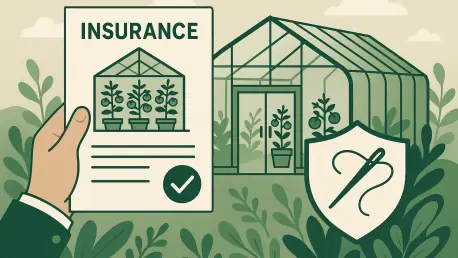The commercial greenhouse sector in North America is experiencing remarkable growth, with a market value pegged at $5.9 billion in 2024 and an expected surge to $11.4 billion by 2031, driven by an insatiable demand for year-round fresh produce and locally sourced plants. This rapid expansion underscores a pressing need for greenhouse operators to shield their investments from the myriad risks inherent in their trade. Standard business insurance policies, often designed for more generic enterprises, frequently fail to address the specialized challenges faced by these operations. From delicate structures prone to damage to crops highly sensitive to environmental shifts, the vulnerabilities are unique and complex. Exploring the necessity of customized insurance reveals how it serves not just as a financial buffer but as an essential tool for sustaining greenhouse businesses in a competitive and unpredictable market.
Understanding the Unique Risks of Greenhouse Operations
Specific Threats to Financial Stability
The financial health of greenhouse businesses hinges on their ability to mitigate risks that are far from typical. Crop losses, often triggered by failures in climate control systems, can devastate income streams in mere hours. A sudden breakdown in heating or cooling can ruin entire harvests, leaving operators without the means to replant if structural damages compound the issue. Commercial property insurance emerges as a critical safeguard in such scenarios, offering compensation for damaged crops and lost revenue. Without this tailored protection, the economic fallout from a single incident could force a business into a downward spiral, highlighting the inadequacy of generic policies that overlook the nuanced needs of horticultural operations.
Beyond crop vulnerabilities, storm damage poses a significant threat to the structural integrity of greenhouses across various regions. Severe weather events like hail, high winds, or heavy snow can shatter glass or polycarbonate panels, leading to costly repairs and operational halts. Property insurance tailored to these risks ensures that the expenses for rebuilding and the income lost during downtime are covered. This kind of coverage is particularly vital for operations in areas prone to extreme weather, where the likelihood of such disruptions is higher. By addressing these specific structural risks, customized insurance helps greenhouse operators maintain stability even when nature strikes with full force.
Operational and Safety Challenges
Electrical fires represent a less visible but equally destructive risk for greenhouse businesses, often stemming from aging wiring or poor connections. Such incidents can lead to significant property damage and prolonged business interruptions, with recovery times stretching into weeks or months. Business interruption insurance plays a pivotal role here, covering lost income and additional expenses incurred to keep operations afloat during the recovery period. This type of tailored coverage ensures that a fire does not translate into a complete financial collapse, providing a lifeline for businesses grappling with the aftermath of such disasters.
Equipment breakdowns and workplace hazards further complicate the operational landscape for greenhouse operators. Machinery failures, such as a malfunctioning irrigation system, can halt production and incur steep repair costs, while injuries from slips on wet floors or falls from ladders can lead to workers’ compensation claims. Equipment breakdown coverage addresses the financial strain of repairs, while proactive safety measures, often supported by insurers, help reduce injury risks. Tailored policies that include these protections allow businesses to focus on growth rather than being bogged down by preventable setbacks, ensuring a safer and more efficient working environment.
Benefits of Tailored Insurance for Greenhouse Businesses
Financial Protection and Continuity
Tailored insurance stands as a cornerstone for greenhouse businesses, offering robust financial protection against the unpredictable nature of their industry. When disasters strike—be it a storm demolishing structures or a system failure ruining crops—customized policies ensure that owners are not left to bear the full brunt of the costs. This safety net prevents a single event from derailing years of hard work, providing compensation for damages and lost revenue. Such coverage is indispensable for maintaining the economic viability of operations, especially in a market where margins can be tight and recovery periods lengthy.
Equally important is the role of tailored insurance in supporting operational recovery after a setback. Beyond merely covering losses, these policies often account for additional expenses incurred during downtime, such as temporary facilities or expedited repairs to resume production. This support minimizes the duration of interruptions, allowing businesses to bounce back swiftly and maintain customer trust. By addressing both immediate losses and the broader recovery process, customized insurance ensures that greenhouse operations remain resilient in the face of adversity, safeguarding their long-term sustainability.
Proactive Risk Management
Partnering with insurers who bring specialized expertise to the table offers greenhouse businesses more than just financial coverage; it provides access to proactive risk management strategies. Tools like thermal imaging to detect potential electrical issues before they escalate into fires, or detailed risk assessments to identify structural weaknesses, can prevent disasters from occurring in the first place. Insurers with a deep understanding of the horticultural sector often guide operators in implementing these measures, reducing the likelihood of costly incidents and enhancing overall operational safety.
Compliance with state-specific regulations is another critical benefit of working with knowledgeable insurance providers. Greenhouse businesses must navigate a complex web of legal requirements that vary by region, and failing to meet these standards can result in penalties or operational shutdowns. Specialized insurers offer guidance to ensure that policies align with local laws, protecting businesses from legal pitfalls. This dual focus on prevention and compliance underscores the value of tailored insurance, as it not only mitigates risks but also fortifies the legal and operational framework of greenhouse enterprises.
Choosing the Right Insurance Partner
Expertise in the Horticultural Industry
Selecting an insurance provider with deep-rooted expertise in the horticultural industry can significantly elevate the protection level for greenhouse businesses. Companies like Hortica®, with over a century of experience, understand the intricate details of these operations—from the materials used in greenhouse construction to the specific crops cultivated. This specialized knowledge translates into policies that are meticulously crafted to address the unique risks faced by each business, ensuring that coverage is neither excessive nor insufficient but precisely aligned with actual needs.
Moreover, the customization offered by such insurers allows for policies that reflect the individual characteristics of a greenhouse operation. Factors like the type of plants grown, the construction materials in use, and even the business’s historical risk profile are taken into account when designing coverage. This bespoke approach ensures that operators are not paying for irrelevant protections while still securing comprehensive safeguards against pertinent threats. The result is a partnership that not only protects but also empowers businesses to operate with confidence in a specialized field.
Adapting to Operational Scale and Location
The diversity in scale among greenhouse operations necessitates a flexible approach to insurance coverage. Larger facilities, with greater exposure to risks due to their size, might opt for higher deductibles to balance premiums with adequate protection, while smaller setups may prioritize lower deductibles for more immediate financial relief. Tailored policies can be adjusted to match these varying needs, ensuring that coverage scales appropriately with the operation’s capacity and risk profile, thereby offering a practical solution for businesses of all sizes.
Regional differences also play a crucial role in shaping insurance needs, as climate and weather patterns vary widely across North America. A greenhouse in a snowy state like Minnesota faces heightened risks from boiler failures or structural collapse under snow loads, whereas one in a warmer area like Florida might prioritize coverage for hurricane damage. Customized insurance accounts for these geographic nuances, providing specific protections that align with local conditions. This adaptability ensures that greenhouse businesses receive relevant and effective coverage, enabling them to thrive regardless of where they are located.
Securing Future Growth with Strategic Coverage
Reflecting on the journey through the challenges and solutions for greenhouse businesses, it becomes clear that tailored insurance has been a linchpin for their stability in past years. Specialized policies address unique risks like crop losses and storm damage with precision, while partnerships with experienced insurers offer proactive strategies to prevent issues before they arise. The focus on customization, accounting for operational scale and regional variances, proves instrumental in safeguarding financial health. Moving forward, greenhouse operators should prioritize aligning with knowledgeable providers to craft coverage that evolves with their needs. Exploring risk management tools and ensuring compliance with local regulations will further fortify their resilience. As the industry continues to expand, investing in strategic insurance solutions remains a vital step to secure sustained growth and navigate future uncertainties with confidence.









